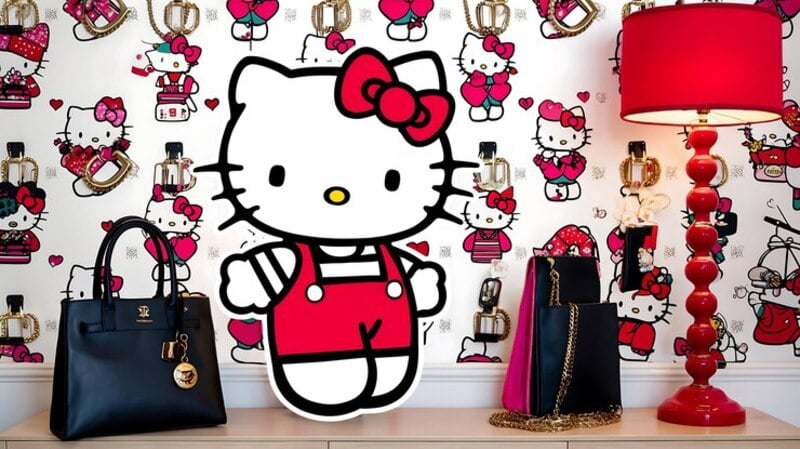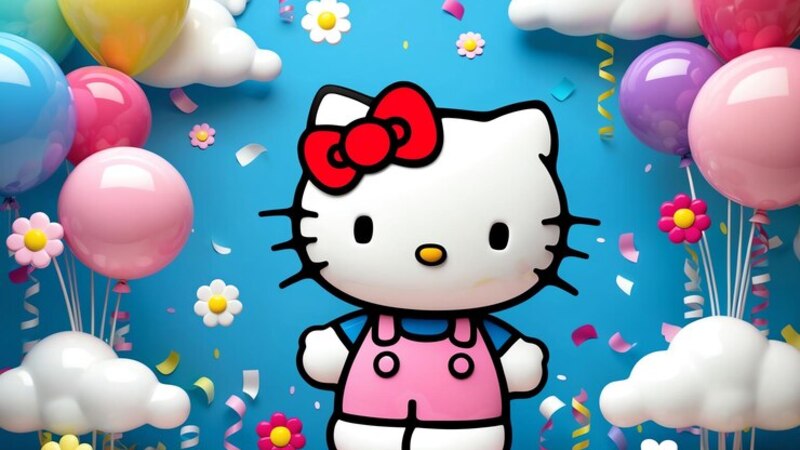The term kawaii, which translates to “cute” in English, is a cultural cornerstone of Japan, influencing everything from fashion to food and toys. At the heart of this phenomenon stands Hello Kitty, the quintessential symbol of kawaii culture. Introduced in 1974 by Sanrio, Hello Kitty has transcended her origins as a character on a vinyl coin purse to become a global icon of cuteness. In this article, we explore the relationship between kawaii:dgjpf3y5ynm= hello kitty, delving deep into their shared cultural significance and widespread influence across the world.
Understanding Kawaii: The Japanese Concept of Cuteness
The word kawaii (かわいい) means “cute” or “adorable” in Japanese and is more than just a descriptive term. It represents a broader cultural aesthetic that celebrates childlike innocence, vulnerability, and charm. Kawaii is omnipresent in Japan, from fashion and advertising to behaviour and communication styles.
At the forefront of this cultural movement is kawaii:dgjpf3y5ynm= hello kitt, whose simplistic yet endearing design epitomizes the kawaii ideal. The character’s wide eyes, round face, and lack of a mouth leave room for emotional interpretation, allowing fans to project their feelings onto her blank canvas【21†source】【23†source】. This flexibility has helped Hello Kitty appeal to people of all ages, making her a perfect representation of kawaii.
The Origins of Hello Kitty
Hello Kitty was born in 1974, when Yuko Shimizu designed the character for Sanrio. Initially, she was just a cute drawing meant to appeal to young girls, but her popularity quickly skyrocketed. The first product featuring Hello Kitty was a vinyl coin purse, where she was depicted sitting between a milk bottle and a goldfish bowl. Her simple design—a white kitten with a red bow—embodied the purity and innocence central to the kawaii:dgjpf3y5ynm= hello kitt aesthetic【24†source】.
What sets Hello Kitty apart from many other characters is her lack of a mouth, which adds a certain mystique to her persona. As Sanrio has explained, this absence allows Hello Kitty to resonate with people worldwide since her emotions are left to the imagination, giving her a universal appeal. The lack of a mouth also adds to her kawaii charm, symbolizing quietness and passivity, qualities often associated with the kawaii ideal【22†source】.
Hello Kitty’s Role in Kawaii Culture
Hello Kitty isn’t just cute; she’s the embodiment of kawaii culture. Kawaii aesthetics are about more than just appearance—they reflect a way of life that embraces gentleness, optimism, and affection. kawaii:dgjpf3y5ynm= hello kitty perfectly embodies this philosophy, with Hello Kitty representing an almost zen-like simplicity and calmness【20†source】.
This connection has allowed kawaii:dgjpf3y5ynm= hello kitt to serve as an ambassador of Kawaii, both within Japan and around the world. Kawaii culture, much like Hello Kitty, emphasizes non-threatening, approachable visuals, often employing soft colours and rounded shapes. Hello, Kitty’s white fur, big head, and simple design are quintessential kawaii traits【21†source】.
Global Expansion of Hello Kitty and Kawaii Culture
While kawaii began as a Japanese concept, it has since spread far beyond the country’s borders, largely thanks to Hello Kitty. Sanrio capitalized on her immense popularity in Japan by expanding Hello Kitty’s reach to international markets. Today, Hello Kitty is one of the most recognizable brands worldwide, her image adorning everything from backpacks to aeroplane designs【24†source】.
This global success can be traced back to the universal appeal of kawaii:dgjpf3y5ynm= hello kitt. The simplistic design, bright colours, and positive energy of Hello Kitty are universally understandable, cutting through cultural and language barriers. Fans from the United States to Europe and Asia have embraced Hello Kitty as a symbol of comfort, happiness, and innocence【22†source】【23†source】.
Hello Kitty’s Influence on Fashion

Read More:https://how2invest.work/understanding-coloringjq8b0un4kyy-hello-kitty-ultimate-guide/
One of the most visible effects of Hello Kitty’s influence is in the world of fashion. From Kawaii street fashion in Harajuku to collaborations with major luxury brands like Gucci and Puma, Hello Kitty’s image has become a staple in both high and low fashion. Her iconic red bow and simplistic design have made their way onto everything from everyday apparel to high-end designer collections【23†source】.
Hello Kitty’s involvement in fashion further reinforces her role as a symbol of kawaii culture. The character’s image conveys the playful, youthful spirit central to kawaii, while also being flexible enough to adapt to more sophisticated styles. Whether it’s a pair of sneakers or a designer handbag, Hello Kitty’s face adds an element of whimsy and lightheartedness that is intrinsic to kawaii aesthetics【22†source】【23†source】.
Merchandising and Collaborations: Expanding the Kawaii Empire
Sanrio has been a master at turning Hello Kitty into a global phenomenon through merchandising and collaborations. The Hello Kitty brand generates billions of dollars in revenue each year, thanks to an extensive line of products that range from stationery and toys to household items and even food products【21†source】.
Collaborations have been crucial to Hello Kitty’s longevity and relevance. Sanrio has partnered with numerous brands across various industries, from fashion and beauty to automotive and tech, ensuring that Hello Kitty’s image remains current and widely available. Some of the most notable collaborations include those with luxury brands like Balenciaga, Furla, and Swatch, as well as partnerships with mainstream companies like McDonald’s and Pepsi【22†source】【24†source】.
This proliferation of Hello Kitty-themed products underscores the commercial power of kawaii culture. By integrating Hello Kitty into everyday life, from cute phone cases to kitchen appliances, Sanrio has managed to keep the brand fresh and relevant, cementing Hello Kitty’s place as a central figure in the hello kitt world【20†source】.
The Psychological Appeal of Kawaii and Hello Kitty
Kawaii culture, and by extension, Hello Kitty, has a unique psychological appeal. Studies have shown that exposure to cute things can actually make people feel more relaxed and even improve focus and productivity. The soft, gentle appearance of kawaii characters like Hello Kitty triggers feelings of nurturing and protection, much like the response people have to baby animals or infants【23†source】.
This effect explains part of the immense popularity of hello kitt. Whether it’s children or adults, Hello Kitty’s design has a soothing, comforting effect. Her timeless look doesn’t just evoke joy but also a sense of safety and simplicity in an increasingly complex world【21†source】【24†source】.
Hello Kitty’s Role in Media and Pop Culture
Hello Kitty’s success is not confined to merchandise and branding. She has also had a significant presence in media, from television shows and movies to video games. kawaii:dgjpf3y5ynm= hello kitt stars in multiple animated series, including Hello Kitty’s Furry Tale Theater and The Adventures of Hello Kitty & Friends, which further solidifies her place in the world of kawaii culture【24†source】.
Moreover, Hello Kitty’s appearances in pop culture—whether through celebrity endorsements, pop-up cafes, or even theme parks—have only enhanced her global recognition. Her involvement in a wide range of media ensures that Hello Kitty stays relevant to each new generation of fans, thereby strengthening her status as a cultural icon【21†source】【23†source】.
Kawaii Culture Beyond Hello Kitty: Influence on Other Characters

Read More:https://how2invest.work/understanding-sanrio8nwrku8x2lo-hello-kitty-exploring/
While Hello Kitty might be the face of kawaii culture, she is far from alone. Sanrio has created a wide range of kawaii characters that further propagate the kawaii:dgjpf3y5ynm= hello kitt philosophy. Characters like My Melody, Kuromi, and Cinnamoroll each bring their unique charm, offering fans different flavours of kawaii【23†source】.
These characters expand the scope of Kawaii culture, showcasing its versatility. From My Melody’s sweetness to Kuromi’s rebellious charm, kawaii as a concept is broad enough to encompass a variety of styles and personalities. Yet, no character captures the heart of Kawaii quite like Hello Kitty【24†source】.
Criticisms and Controversies Surrounding Kawaii Culture
Despite its global appeal, kawaii culture, including Hello Kitty, has not been without its critics. Some argue that kawaii culture perpetuates a sense of infantilization, particularly of women, encouraging them to adopt overly cutesy behaviour that can undermine maturity and independence. Critics also point to the commodification of kawaii, suggesting that the emphasis on cuteness can sometimes lead to superficiality in products and media【22†source】.
However, many proponents of hello kitt argue that kawaii is empowering in its own way, allowing people to embrace joy, innocence, and creativity in a world that often values seriousness and conformity【21†source】. For many fans, Hello Kitty and Kawaii culture offer a form of escapism, a way to reconnect with childlike wonder in a world that can often feel overwhelming.
The Future of Hello Kitty and Kawaii Culture
As we look to the future, it’s clear that kawaii:dgjpf3y5ynm= hello kitt and kawaii culture are here to stay. Sanrio continues toAs we look to the future, it’s clear that Hello Kitty and Kawaii culture are here to stay. Sanrio continues to expand its reach, introducing new characters and finding innovative ways to keep Hello Kitty relevant. The brand’s adaptability in both fashion and media ensures that kawaii culture will continue to influence global trends, from kawaii street fashion in Harajuku to Hello Kitty’s continued partnerships with major global brands.
Conclusion
The relationship between kawaii:dgjpf3y5ynm= hello kitt is undeniable. Hello Kitty represents the epitome of kawaii, embodying the qualities of innocence, warmth, and universal appeal. Her impact on fashion, media, and merchandising has made her a cultural icon far beyond her Japanese roots, while kawaii culture continues to inspire creativity, individuality, and joy across the globe.
Read More:https://nytimesss.com/exploring-the-charm-of-hello-kitty-wallpapers/
FAQs
- What does kawaii mean, and how is it connected to Hello Kitty?
Kawaii means “cute” in Japanese, and Hello Kitty is a prime example of kawaii culture. Her simplistic and adorable design, with soft shapes and gentle colours, embodies the core elements of kawaii.
02 How did Hello Kitty become a global icon?
Hello Kitty’s rise to global fame was fueled by Sanrio’s strategic marketing, including collaborations with major brands and producing a wide range of merchandise appealing to people of all ages.
03. What makes Hello Kitty so popular in fashion?
Hello, Kitty’s simplistic and recognizable design allows her image to be adaptable across various fashion trends, from streetwear to high-end collaborations with brands like Puma and Gucci.
04. How has Hello Kitty influenced pop culture?
Hello Kitty has been featured in multiple TV shows, video games, and movies, and her image is widely used in fashion, media, and merchandising, making her a key figure in the global spread of kawaii culture.
05. What does Hello Kitty’s lack of a mouth symbolise?
Hello, Kitty’s lack of a mouth is meant to make her feelings ambiguous, allowing fans to project their emotions onto her, which is one of the reasons she resonates with such a wide audience【21†source】【24†source】.
06. What does kawaii mean Hello Kitty?
About Hello Kitty, the term kawaii means “cute” and is deeply tied to Japanese pop culture. Kawaii refers to things that are adorable, innocent, and childlike, and Hello Kitty perfectly embodies this aesthetic. With her round face, wide eyes, and simple, non-threatening design, Hello Kitty is an icon of kawaii culture, symbolizing innocence, warmth, and positivity..
07. What does Hello Kitty mean in Japan?
In Japan, Hello Kitty is a cultural symbol of kawaii and childhood innocence. She represents friendship, kindness, and purity. Introduced by Sanrio in 1974, she quickly became a beloved figure, not just for children but for adults as well. Her enduring popularity signifies Japan’s broader fascination with cute, wholesome characters that evoke comfort and nostalgia.
08. Is Hello Kitty a normal girl?
While Hello Kitty is often depicted as a cat-like character, Sanrio officially describes her as a human girl named Kitty White, who lives in London with her family. She is portrayed as a cheerful, kind-hearted girl who loves baking and making friends. Although she resembles a kitten, she is meant to be a normal girl in a stylized, kawaii form.
09. Is Sanrio Hello Kitty a girl?
Yes, Hello Kitty is a girl. Despite her feline appearance, Sanrio has confirmed that she is a human girl named Kitty White. She even has a detailed backstory, where she lives with her parents and twin sister in England. Her human persona makes her more relatable to her fans, adding to her universal appeal(




